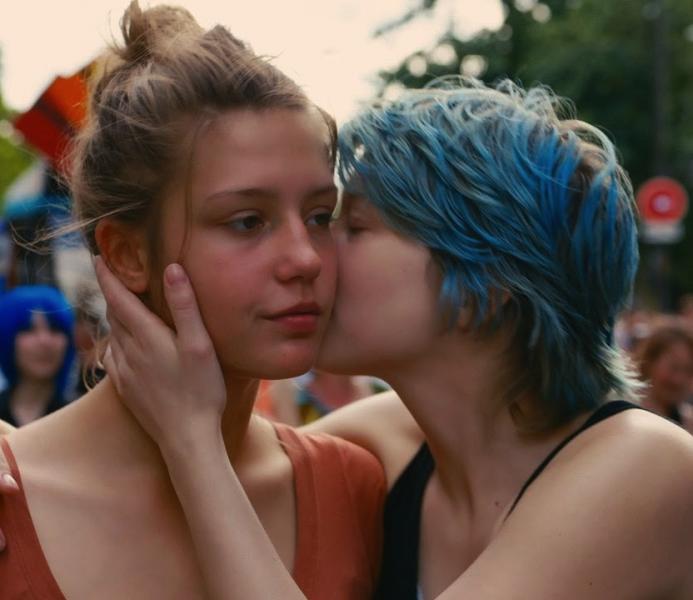Blue Is The Most Controversial Color

With the American release of "Blue is the Warmest Color," residents are picking up on the buzz and discussion about the film and its behind-the-scenes secrets.
Following the outpouring of support and admiration for the film at Cannes (it went home with the prestigious Palme d’Or), the leading ladies, Adele Exarchopoulos and Lea Seydoux, began to share tales of director Abdellatif Kechiche’s aggressive filming tactics.
Kechiche’s impact was mental, emotional and physical. Seydoux explained, “the problem on this film was not the difficulty of the process. It was something else. [points to her head].”
Exarchopoulos explains that the work “was kind of humiliating sometimes, I was feeling like a prostitute. Of course, he uses that sometimes…it was more difficult to show my feelings than my body,” (Aftab).
Kechiche took ten days to shoot the longest sex scene in the movie (which runs about seven minutes) and during a fight scene in which they actually hit each other, filming continued after Exarchopoulos cut herself on a glass door. Both women were aware of Kechiche’s work ethic and signed on regardless.
In Interview, Seydoux said, “I wanted to do the film because I was just thinking about the piece of art that the film could be… But to be a part of this film I had to accept his process” (Wolff).
And at 19 with little previous experience, Exarchopoulos jumped at the chance to work with such a renowned director.
These types of war stories are not reserved to Cannes prizewinners, but rather have occurred in other films between dominant directors and their leading ladies. Shelly Duvall experienced similar anguish working with Stanley Kubrick on The Shining.
“I had to cry 12 hours a day, all day long, the last nine months straight,” Duvall said in an interview with Roger Ebert. Tippi Hedren suffered physical torment on the set of "The Birds" with Alfred Hitchcock. She was told mechanical birds similar to those used previously in the film would be utilized for the attic scene. “But everybody had lied to me,” said Hedren as the assistant director came in and told her “the mechanical birds don’t work, so we have to use real ones,” (Hiscock).
Which brings me to the dilemma, are such abusive tactics worth it? Such behavior becomes justifiable when the film becomes highly acclaimed—as "The Birds," "The Shining" and "Blue" are—but would the film have even been so highly regarded without the forceful nature of the director? In an atypical display of recognition, the Palme d’Or was awarded to not only the director, but also the two lead actresses, demonstrating that it was the performances of all three that made the film so spectacular. This achievement then justifies the director’s abusive tactics. The actors themselves seem to prioritize the final product over the process.
“I think the result is what is important. I think it’s a beautiful result and beautiful film, I want to do beautiful films and it’s not about me,” according to Seydoux.
But this controversy about filming practices and emotional exploitation is only scratching the surface of a larger debate regarding male gaze. The issue of ‘male gaze’-defined by Laura Mulvey as the male perspective which “projects its phantasy on to the female form which is styled accordingly”-is incorporated into the critics discussion of the film.
New York Times columnist Manohla Dargis aggressively stated that “the movie feels far more about Mr. Kechiche’s desires than anything else." She claims that his hand-held camera work seemed to favor the shots he wanted to see as a male watching two women make love, rather than as a director sharing intimate moments for the sake of good cinema. Dargis also quotes art critic John Berger who observed that in 1972 “men look at women [and] women watch themselves being looked at” as a means of emphasizing the work in "Blue." Still relevant today, the core issue is that women are watching themselves portrayed as men see them. Through continued use of this male gaze, such skewed understanding of ourselves has become normalized.
Also weighing in with similar displeasure was Julie Maroh, the 27-year-old author of the French graphic novel on which the movie is loosely based. Among her complaints was “guys [were] too busy feasting their eyes on an incarnation of their fantasies on screen” (Sciolino). The film struck her as “a brutal and surgical display, exuberant and cold, of so-called lesbian sex, which turned into porn” (Sciolino).
After seeing the film myself, I agree with these women to the extent that the sex scenes seemed to favor the male fantasy. But I think discussion of the male gaze issue is overshadowing the strong cinema on display in "Blue." Maybe it’s because I’m not familiar with lesbian sex and therefore its potential misrepresentation, or other movies featuring excessive explicit content and therefore how in this film it seemed gratuitous, but these scenes are visceral demonstrations of the passion present in Adele and Emma’s relationship, and I didn’t have a problem with them. Their intimacy was artfully displayed, and while slightly voyeuristic in viewpoint, never so brutal as to be pornographically exploitative.
But maybe I’m just an example of how female cinematic portrayals, whether sexual or not, are displayed in this way through the ‘male gaze’ and maybe I’ve been normalized to accept this sexist view. At any rate, my biggest quibble was with the length of these scenes. One lasts around seven minutes in its duration, and while spanning that length of time for the sake of realism is admirable, the point was conveyed at the five-minute mark. If anything, the duration of the scenes causes them to feel pornographic because Kechiche gives us no choice but to stare at this intimacy and eventually get over the fact that we’ve been watching these women for more than five minutes in their most vulnerable, yet emotionally volatile state. This issue returns us to the male gaze and maybe the larger issue that women are still being portrayed in an exploitative light in cinema.
READ MORE: Film Review: 'Blue Is The Warmest Color'
The negative discourse on "Blue" comes mostly from women scorned by the portrayal of female-on-female intimacy. In many attempts to find a male opinion on the subject, I found none, which initially would indicate that only women are angry at this film. However, female film critic B Ruby Rich in a recent NPR story stated that “American critics need to get over their obsession with explicit sex. "Blue is the Warmest Color" is not a film about sex. It’s a film about a relationship that sparks across a societal divide” (Qureshi). Maybe we need to see past the most dramatic portions of films as a means of understanding the larger message. In still searching for a male voice amongst those of distained women, I began to wonder if men didn’t express similar discontent because they didn’t discern and comprehend the almost-exploitation being displayed. Perhaps they are so normalized to these portrayals of women that they don’t understand the harm, which again is a larger problem. Or in a more unlikely circumstance, they felt as though they didn’t have the authority to begin expressing their opinions on the subject for fear of the backlash of ‘trying to understand’ women’s issues when they are the cause of them.
These dissenting opinions—now more prominent than before—still remain outnumbered by the praise for the film. Jon Frosch of The Atlantic marvels at how Kechiche “proves once and for all that realism does not have to be austere or punishing” but rather “his film is warm and sensually alive, the camera sticking close to the actors’ faces and bodies without fetishising them.” Jordan Mintzer of The Hollywood Reporter claims the bedroom scenes are “a far cry from softcore porn or art-house exploitation” but rather demonstrate that “sex and love can, in the best cases, become one and the same, uniting two people who might actually have less in common than they believe.”
Even President of the Jury at Cannes Mr. Steven Spielberg had positive remarks about the film, “we were absolutely spellbound by the two brilliant actresses, and the way the director observed his young players” (Pulver). And it’s not only men that support the film. Ann Hornaday of the Washington Post explains that what sets "Blue" “apart from sensationalism or pulp are the daily moments that precede and follow the more notorious sex sequence”. These opinions in support of the film present a perspective in favor of the artistry involved in so truthfully telling a love story. And this time while searching for a female voice of support, I discovered that the majority of prominent film critics are male. No wonder we all experience a male perspective, they’re the only ones watching and reporting.
The problem remains that this praise is overshadowing the issue of gender perspective plaguing modern cinema. And once award season begins the discussion will turn to the individual performances of the actresses and in another exploitive nature be reduced to discussion of what they’re wearing on the red carpet. Women are still being portrayed as men see them and are being discussed not for their worth as humans but as bodies on screen and in dresses.
I don’t have a good answer to any of these dilemmas, but I will offer a suggestion for the cinematic exploitation practices. Since the problems seem to occur on set between directors and their actors, why not extend the audition process into more of a pre-screening process to fully understand whether the actor is capable of such demands. I understand that this suggestion could easily be met with an unsavory response because the audition process is already so cumbersome and risky, and you can only predict so much. But the issue with suggesting a solution or picking a side in this dilemma is the conceptualization of filming and acting as processes. Compared to other dilemmas where funding, decision-making, or other impersonal processes might be the issue, acting is highly personal and subjective, strongly engaging the individual and their self. Because of humanity’s vast diversity, trying to find a solution that satisfies both the actor and the director is difficult if not impossible. As both operate under highly creative processes, their intersection is already rare and beautiful and trying to push or pull from one side or the other could only weaken the bond and further separate the two.
The use of male gaze in "Blue is the Warmest Color" demonstrates the type of physical and emotional abuse endured by the lead actresses, and is unfortunately representative of a gendered perspective in modern cinema. This exploitation then raises the question whether such practices should be allowed if their result is award-winning cinema. I offer no easy solution but rather a suggestion that the audition process be adjusted to better understand the working habits of both director and actor. My stance on the film is that though three hours, the love story told is more true than any I have seen before, and though Kechiche might have used the male gaze during the sex scenes, their duration in comparison to the film as a whole relegated their importance to a minimal amount.
Reach Contributor Ashley Smith here.



